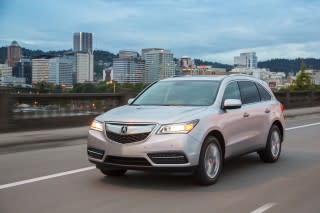2016 Acura MDX Adds Nine-Speed Automatic, More Safety-Tech Features

It’s been barely two years since Acura made its MDX mid-size crossover a little more sport-wagon influenced, with a warmer, more refined cabin and a much-upgraded active-safety and technology feature set.
Now for 2016, with a model that arrives to dealerships beginning this week, the MDX gets another round of updates. Although cosmetically the MDX hasn’t changed, Acura has significantly upgraded the MDX’s features, and it’s subbed in a ZF nine-speed automatic transmission.
ALSO SEE: Midlife Crisis Cars: Men Want Black & Sporty, Women Want Red & Practical
The new transmission in the 2016 Acura MDX weighs 66 pounds less than the former six-speed automatic, according to Acura, and a new version of the brand’s Super Handling All-Wheel Drive system (SH-AWD), with a twin-clutch rear differential, saves another 19 pounds. With the weight reduction, plus enhancements to the AWD system’s effectiveness, Acura claims improved handling from the MDX.
More gears doesn’t make it more fuel-efficient
While the nine-speed will no doubt improve drivability, performance, and general pep over the outgoing six-speed, there is one odd asterisk: the official fuel economy numbers for the MDX actually go down slightly.
MDX versions for 2016 with front-wheel drive earn EPA ratings of 19 mpg city, 27 highway, while those with all-wheel drive get 18/26 mpg. On an EPA Combined cycle basis, that’s down 1 mpg versus 2015.
But there is a way to get that mileage back, more or less. Idle Stop, which will in some conditions shut the engine off at stoplights, to save fuel, is included in top Advance models. The feature raises both the EPA city and combined numbers by 1 mpg on all-wheel-drive models by 1 mpg, to 22 mpg; but within rounding error the Combined number stays the same on front-wheel-drive models, at 23 mpg.
It’s likely that with Idle Stop you’ll see some pretty significant gains in real-world driving—more than the EPA ratings suggest—if your commute requires a lot of stop-and-go driving.

 Yahoo Autos
Yahoo Autos 
